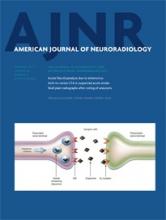Review ArticleReview Articles
Open Access
The Role of Functional Dopamine-Transporter SPECT Imaging in Parkinsonian Syndromes, Part 2
T.C. Booth, M. Nathan, A.D. Waldman, A.-M. Quigley, A.H. Schapira and J. Buscombe
American Journal of Neuroradiology February 2015, 36 (2) 236-244; DOI: https://doi.org/10.3174/ajnr.A3971
T.C. Booth
aFrom the Department of Neuroradiology (T.C.B.), National Hospital for Neurology and Neurosurgery, London, UK
M. Nathan
bDepartment of Nuclear Medicine (M.N., A.-M.Q.), Royal Free Hospital NHS Trust, London, UK
A.D. Waldman
cDepartment of Imaging (A.D.W.), Imperial College Healthcare NHS Trust, London, UK
A.-M. Quigley
bDepartment of Nuclear Medicine (M.N., A.-M.Q.), Royal Free Hospital NHS Trust, London, UK
A.H. Schapira
dDepartment of Clinical Neurosciences (A.H.S.), Institute of Neurology, University College London, London, UK
J. Buscombe
eDepartment of Nuclear Medicine (J.B.), Addenbrooke's Hospital, Cambridge University Hospitals NHS Foundation Trust, Cambridge, UK.

REFERENCES
- 1.↵
- 2.↵
- Catafau AM,
- Tolosa E
- 3.↵
- Quinn N
- 4.↵
- Papp MI,
- Lantos PL
- 5.↵
- Schrag A,
- Good CD,
- Miszkiel K, et al
- 6.↵
- 7.↵
- Ghaemi M,
- Hilker R,
- Rudolf J, et al
- 8.↵
- Brenneis C,
- Seppi K,
- Schocke MF, et al
- 9.↵
- Schulz JB,
- Skalej M,
- Wedekind D, et al
- 10.↵
- Schocke MF,
- Seppi K,
- Esterhammer R, et al
- 11.↵
- Nicoletti G,
- Lodi R,
- Condino F, et al
- 12.↵
- Ito M,
- Watanabe H,
- Kawai Y, et al
- 13.↵
- Watanabe H,
- Fukatsu H,
- Katsuno M, et al
- 14.↵
- Berg D,
- Godau J,
- Walter U
- 15.↵
- Brooks DJ,
- Salmon EP,
- Mathias CJ, et al
- 16.↵
- Antonini A,
- Leenders KL,
- Vontobel P, et al
- 17.↵
- Brücke T,
- Asenbaum S,
- Pirker W, et al
- 18.↵
- Benamer TS,
- Patterson J,
- Grosset DG, et al
- 19.↵
- 20.↵
- Seeman P,
- Niznik H
- 21.↵
- Costa DC,
- Verhoeff NP,
- Cullum ID, et al
- 22.↵
- Ichise M,
- Ballinger JR,
- Vines D, et al
- 23.↵
- Churchyard A,
- Donnan GA,
- Hughes A, et al
- 24.↵
- van Royen E,
- Verhoeff NPLG,
- Speelman JD, et al
- 25.↵
- Schwarz J,
- Tatsch K,
- Gasser T, et al
- 26.↵
- Yekhlef F,
- Ballan G,
- Macia F, et al
- 27.↵
- 28.↵
- Brenneis C,
- Seppi K,
- Schocke MF, et al
- 29.↵
- Price S,
- Paviour D,
- Scahill R, et al
- 30.↵
- Blain CR,
- Barker GJ,
- Jarosz JM, et al
- 31.↵
- Seppi K,
- Schocke MF,
- Esterhammer R, et al
- 32.↵
- Brooks DJ,
- Ibanez V,
- Sawle GV, et al
- 33.↵
- 34.↵
- Antonini A,
- Benti R,
- De NR, et al
- 35.↵
- Vlaar AM,
- van Kroonenburgh MJ,
- Kessels AG, et al
- 36.↵
- 37.↵
- Kim YJ,
- Ichise M,
- Ballainger JR, et al
- 38.↵
- Vlaar AM,
- de Nijs T,
- Kessels AG, et al
- 39.↵
- Plotkin M,
- Amthauer H,
- Klaffke S, et al
- 40.↵
- Südmeyer M,
- Antke C,
- Zizek T, et al
- 41.↵
- Gröschel K,
- Hauser TK,
- Luft A, et al
- 42.↵
- Boxer AL,
- Geschwind MD,
- Belfor N, et al
- 43.↵
- Erbetta A,
- Mandelli ML,
- Savoiardo M, et al
- 44.↵
- 45.↵
- 46.↵
- 47.↵
- Stevens T,
- Livingston G,
- Kitchen G, et al
- 48.↵
- Ala TA,
- Yang KH,
- Sung JH, et al
- 49.↵
- McKeith I,
- Fairbairn A,
- Perry R, et al
- 50.↵
- Ditter SM,
- Mirra SS
- 51.↵
- Barber R,
- Gholkar A,
- Scheltens P, et al
- 52.↵
- Whitwell JL,
- Weigand SD,
- Shiung MM, et al
- 53.↵
- 54.↵
- 55.↵
- Lobotesis K,
- Fenwick JD,
- Phipps A, et al
- 56.↵
- Gilman S,
- Koeppe RA,
- Little R, et al
- 57.↵
- Piggott MA,
- Marshall EF,
- Thomas N, et al
- 58.↵
- O'Brien JT,
- Colloby S,
- Fenwick J, et al
- 59.↵
- Zijlmans JC,
- Daniel SE,
- Hughes AJ, et al
- 60.↵
- Forno L
- 61.↵
- 62.↵
- Isaias IU,
- Marotta G,
- Hirano S, et al
- 63.↵
- Jeon B,
- Kim JM,
- Jeong JM
- 64.↵
- Borasio GD,
- Linke R,
- Schwarz J, et al
- 65.↵
- Ichiba M,
- Nakamura M,
- Sano A
In this issue
American Journal of Neuroradiology
Vol. 36, Issue 2
1 Feb 2015
Advertisement
T.C. Booth, M. Nathan, A.D. Waldman, A.-M. Quigley, A.H. Schapira, J. Buscombe
The Role of Functional Dopamine-Transporter SPECT Imaging in Parkinsonian Syndromes, Part 2
American Journal of Neuroradiology Feb 2015, 36 (2) 236-244; DOI: 10.3174/ajnr.A3971
0 Responses
Jump to section
Related Articles
- No related articles found.
Cited By...
- No citing articles found.
This article has not yet been cited by articles in journals that are participating in Crossref Cited-by Linking.
More in this TOC Section
Similar Articles
Advertisement











